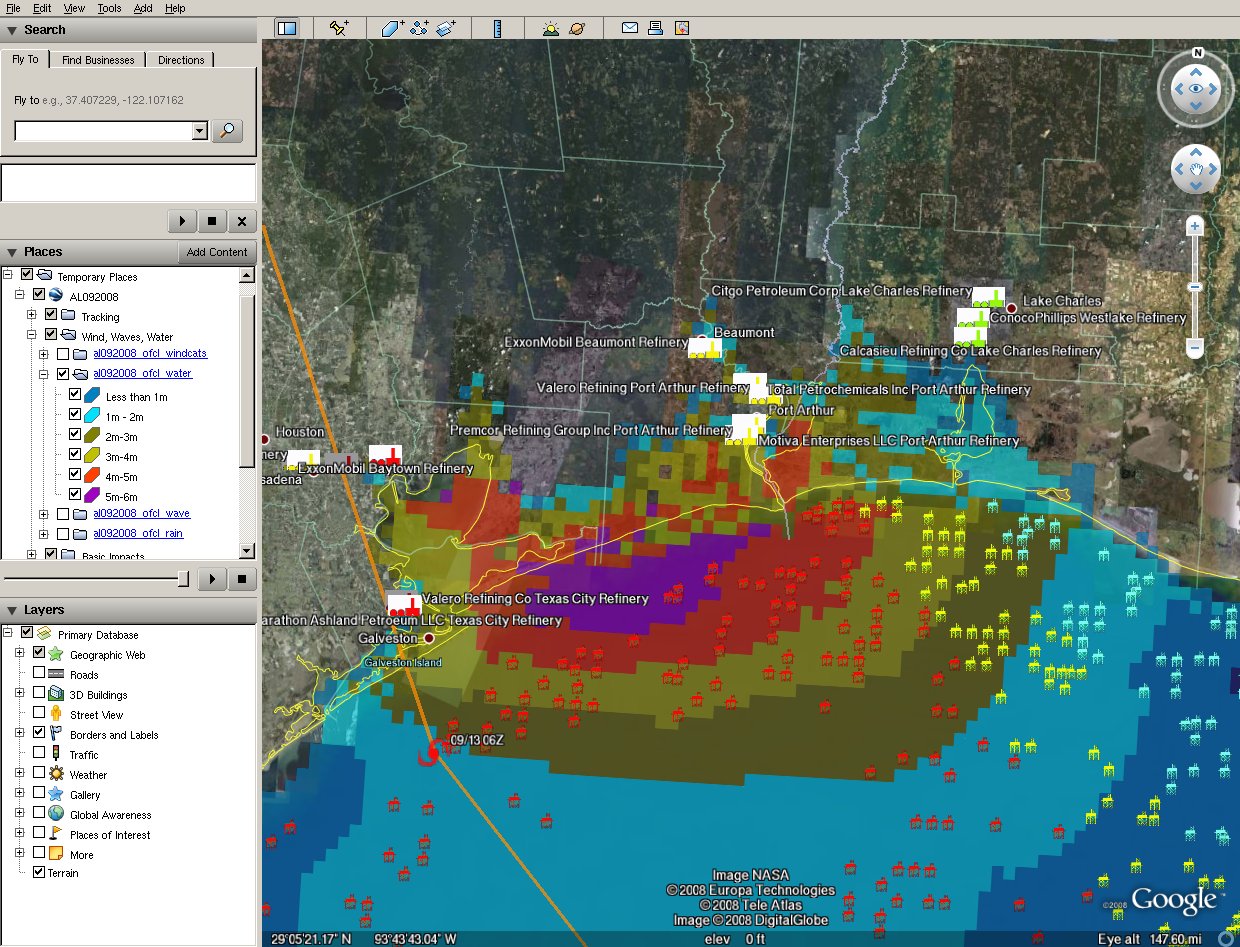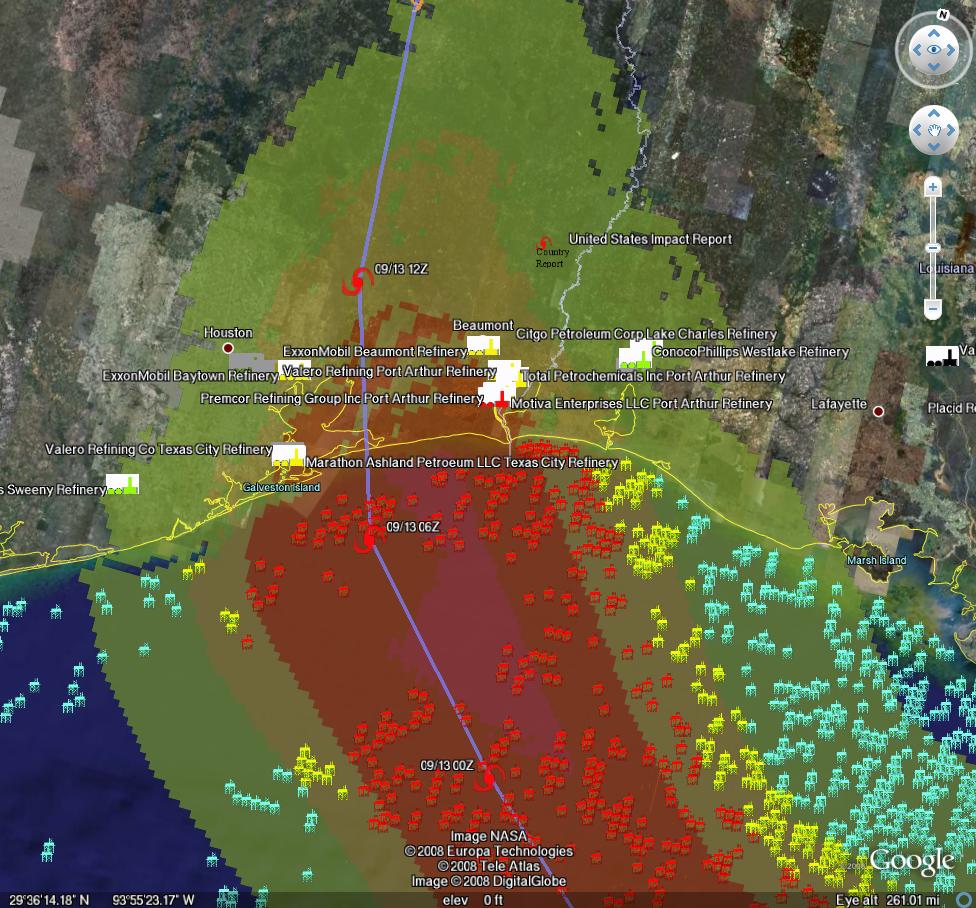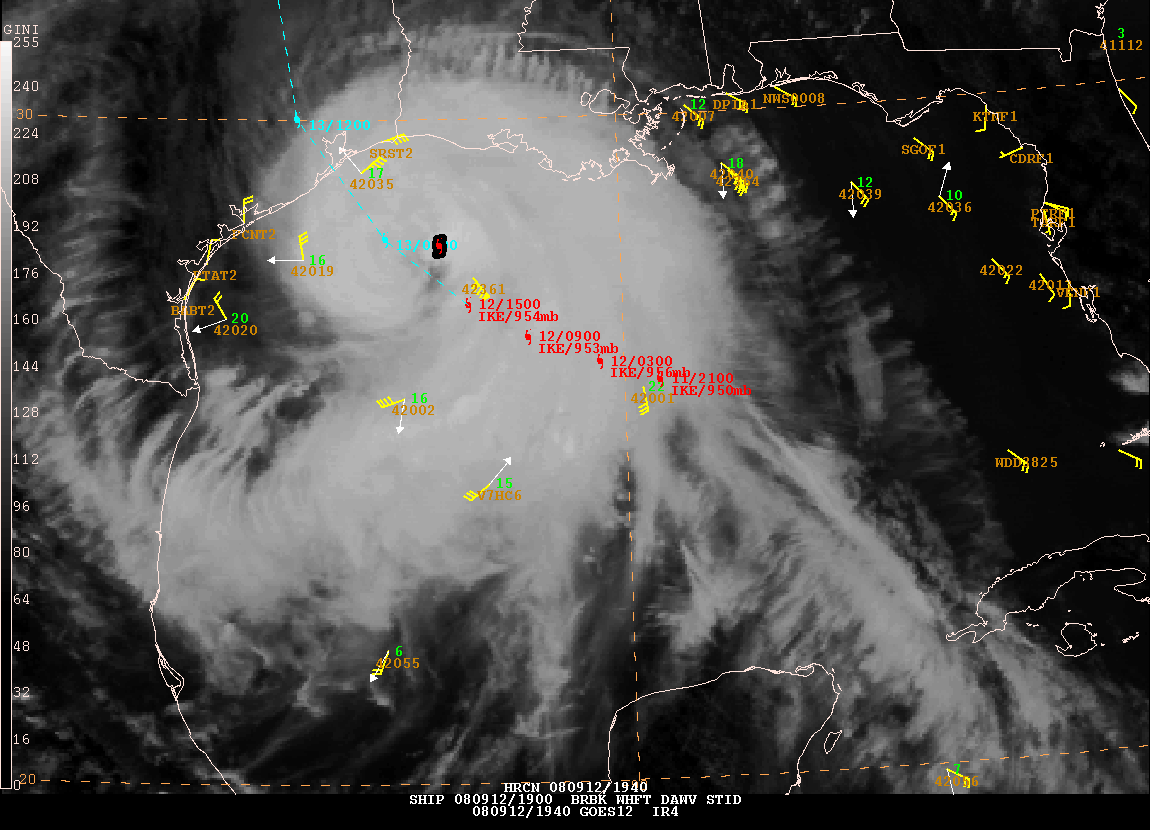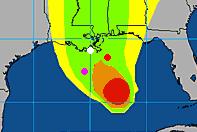Skip to comments.
Hurricane Ike, Energy Infrastructure, Refineries and Damage Models ... (Updated 9/12 18:00 EDT)
The Oil Drum ^
| September 12, 2008
| Nate Hagens
Posted on 09/12/2008 4:13:08 PM PDT by Mike Fieschko
Updated 9/12 1800 EDT. Hurricane Ike's current track currently is headed directly for Houston/Galveston and is expected by the National Hurricane Center to be Category 2 (or perhaps a 3) at a late Friday/early Saturday am landfall, which remains in striking distance of over 5 million bpd of US petroleum refining capacity. (A little perspective: 5 MMBBL is about 30% of US capacity (about 15 MMBBL), and a bit less than 6% of global capacity (~85 MMBBL)).

Current path estimates for Hurricane Ike (Methaz NHC official track Sep 12 (17:00 EDT)-click twice to enlarge--colors represent storm surge from SLOSH models, key on the side-you can see it if you enlarge.

Current path estimates for Hurricane Ike (Methaz HWRF track Sep 12 (9:00 EDT)-click twice to enlarge

Current wave map for Hurricane Ike (Methaz NHC track Sep 12 (16:00 EDT)-click twice to enlarge
For all graphics: Rigs/Platforms: Blue: evacuated only; Yellow will require inspection before restart; Red: damage requiring repair; Refineries: Black: operational impact (partial shutdown) Green: Operational impact (full shutdown) Red: Damage likely; Ports: standard hurricane flags for wind
Here is the latest update from Chuck Watson at KAC/UCF as of Sep 12 (16:00 EDT)
Ike remains atypical in structure. Interestingly, the wave and wind fields are stronger on the back side of the storm than in the right front quadrant, due to wind and fetch considerations. The "eyewall" is visible on radar, and looks to make landfall on the north side of Galveston Bay, to the right of the current NHC track. Expect them to shift a bit north in the next advisory. Given this structure, I seriously doubt Ike can intensify much before landfall. However, the wide wave field and potential for 20ft storm surge along a wide stretch of coastline will still cause a lot of coastal damage.
The track and intensity forecast has enough confidence to start looking at very detailed impacts. Offshore, I'm not expecting much damage. The wave field, while extensive, is within the design margins of all but the older, less productive platforms. 30 ft waves sounds like a lot in the Gulf, and I wouldn't want to be out in it, but you have to get above 50 ft to really cause significant damage.
The refineries remain a significant concern. I'm less concerned about wind, unless we get unlucky and something breaks that shouldn't. The big question now is down to flooding, and the main facility I am worried about is the Texas City complex. If the storm tracks to the NE of the bay, and winds blow offshore, it may avoid flooding. But a leftward wobble could inundate this complex, and take out over 1 MMBBL/day capacity for several months. The big Exxon-Mobil Baytown complex is a bit better protected - the storm will have to take a significant leftward jog to flood it. It looks like Port Arthur area is in for big flooding if the current trends continue, but the refineries are further inland, and if the storm starts moving faster there may not be enough time for the surge to build inland.
30 Day Outage Probabilities (Refinery Capacity):
1 MMBBL: 70%
3 MMBBL: 30%
5 MMBBL: 10%
Chuck at 18:00 EDT:
Three scenarios:
1) 20 miles west: Very Very Bad for Texas City. Very Bad for Baytown. Pt Arthur some damage but not so bad.
2) Direct Hit: Bad for Texas City, Baytown escapes worst of it. Bad for Pt Arthur.
3) 20mi east: Not so bad for Texas City. Baytown Escapes, Pt Arthur? Oh, you mean Lake Arthur.
At the moment, Ike is wobbling just to the right of the NHC track, which is sort of a "2a", and probably the best we can hope for at the moment. I'm thinking/hoping it will thread the needle and cause just coastal flooding due to wave setup and limited storm surge, but no extensive inland flooding. Look carefully at the surge map I sent; virtually all of the surge is to the right of centerline and in between the refineries. That's where we want it (to minimize damage).
Water levels currently running about 5ft above normal. IF the storm stays on track, those levels will actually start to drop in a couple hours as the winds start to blow offshore.
If Ike wobbles left like the last couple of radar frames show, Texas City is toast. If it goes way left, Baytown is in jeopardy. UGH!
Also, the MMS reported today that:
97.5% of the oil production and 94.4 % of the natural gas production in the Gulf has been shut-in; Personnel have been evacuated from a total of 596 production platforms, equivalent to 83.1% of the 717 manned platforms in the Gulf of Mexico; Personnel from 101 rigs have also been evacuated--this is equivalent to 83.5% of the 121 rigs currently operating in the Gulf; that staff has been evacuated from 452 production platforms (63.0%) and 81 rigs (66.9%) – (95.9% of the oil production and 73.1% of the natural gas production has been shut-in as a precautionary measure for Hurricane Ike.)
We will be posting periodic updates of track and damage forecasts here, because one never knows if one of these events will be seminal. We're not hurricane experts at theoildrum.com. Thankfully we have an expert meteorologist who sends us track and damage forecasts relevant to oil and gas infrastructure. What we try to do on this site, (and have been doing for over 3 years), is articulate the fragility and urgency of our nation's, and our world's, energy situation. As Hurricane Ike moves nearer, and professional analysts gauge the impact it may have on our energy infrastructure, feel free to browse our archives of empirically based analyses and perspectives on the many aspects of our energy situation that form the backdrop not only for this hurricane, but for any exogenous event that disrupts the increasingly uneasy balance between energy supply and demand.
Here is a map of the critical pipeline structure expanding outward nationwide from the Houston/Port Arthur area:


NHC Forecast for Hurricane Ike - click to go to Wunderground
Here are depictions of various Texas cities storm surge maps under different Hurricane scenarios from Weather Underground.
Chuck Watson has put together a dynamically updating page that will reflect the latest damage models/forecasts at this link: KAC/UCF models. We will be updating this thread with damage estimate and breaking news as this story unfolds.
A note on our modeling process: we take the official NHC track, the raw computer model tracks like GFDL, HWRF, LBAR, etc, and even run our own in-house fast cycle track/intensity models. These track and intensity estimates are feed to our main hurricane model (TAOS), which computes the wind, waves, storm surge, currents, etc. at each point in our database of over 50,000 elements in the GoM like rigs, platforms, pipelines, pumping stations, refineries, etc. We then have engineering models for each type of infrastructure that calculates the damage and estimated down time for that element, as well as downstream impacts (eg if a pipeline is down, the upstream elements can't pump and the downstream elements don't get product).
PRODUCTION/INFRASTRUCTURE MAPS AND REFINERY INFORMATION
Here's a link to a really good map of oil refining/SPR storage facilities in respect to the path of Katrina (NB: OLD TRACK MAP!) and here is a listing of production and refining capability for the state of LA.

Just to give you a rough idea of where things are, the map above is a probability swath for Katrina (OLD TRACK MAP!) with the Thunder Horse platform as the red dot, and the other purple dot represents the Mad Dog development (100,000 bd); the Holstein development that produces at peak, around 100,000 bd of oil; and the Atlantis field that may have ramped up to around 200,000 bd in all. Put together these projects have the potential of around 650,000 bd, but as can be seen, they were sitting in an uncomfortable spot relative to the track of the Katrina.The white dot is where Port Fourchon is. This is where the Louisiana Offshore Oil Port, or LOOP, is located. Rigzone pointed out that this is where the foreign tankers offload, Google and Terraserve maps you can see that the area is very low-lying. One of the big concerns is that there will be sub-sea landslides or other ground movement that might affect the LOOP. Were this to be disrupted, then foreign tankers would need to be diverted elsewhere, with the likely port being Houston.
Here is a really good link/map (from "Rod and Reel" no less) of the LA southern coastline showing all of the Submersible and Floater Gulf rigs.
We have accumulated resources from previous hurricanes below, but we'd like to find updated materials if you know of them. Recent refinery maps, recent rig maps in the gulf, recent gas fields, SPR facilities, the Intercoastal Canal, pipeline stations and transfer points, etc., etc. Leave links in the comments please.
Also, here's the EIA's Alabama, Louisiana, Mississippi, and Texas Resources pages. They will also likely come in handy. Also, here's a link to the national page.
Here's another good resource for infrastructure maps and such. (scroll down a bit)
Here's a map from CNN with large and small refineries laid out. (though it is an old storm track)
Very detailed piece by RIGZONE on rigs and other infrastructure in the area. (thanks mw)
Here's a flash graphic of the oil refineries and rig maps from Hurricane Rita, it emphasizes Beaumont and Galveston's importance. Click on oil production in the tab. Note the many rigs on the east side of the storm that will get the brunt of the damage from the NE quad of the storm...hence the high long-term GOMEX oil production damage estimates below.
Here's a link to Rigzone's coverage of Ike.
You want a detailed map? Well here's the probably the best MMS map I could find. Very detailed and lots of interesting stuff. (VERY big .pdf warning)
Also, Scott Wilmoth at Simmons & Co sent us this map on deepwater infrastructure. For a complete list of deepwater development systems (includes operator, depth, location): http://www.gomr.mms.gov/homepg/offshore/deepwatr/dpstruct.html

(Please deposit new relevant links, graphs, and comments in this new thread...we have updated the resources part of this post with new maps and some more old maps and articles from Katrina on the LOOP and Port Fourchon--important parts of the infrastructure, as we learned about three years ago. Please leave personal anecdotes and themes unrelated to hurricane for the other upcoming 'bigger picture' posts, as some of these larger images are difficult to upload for those on dial-up)
We will be posting continued updates of track and damage forecasts here, because one never knows when one of these events may have more than just local impacts. We're not hurricane experts at theoildrum.com. Thankfully we have an expert meteorologist who sends us track and damage forecasts relevant to oil and gas infrastructure. What we try to do on this site, (and have been doing for over 3 years), is articulate the fragility and urgency of our nation's, and our world's, energy situation. As Hurricane Ike moves nearer, and professional analysts gauge the impact it may have on our energy infrastructure, feel free to browse our archives of empirically based analyses and perspectives on the many aspects of our energy situation that form the backdrop not only for this hurricane, but for any exogenous event that disrupts the increasingly uneasy balance between energy supply and demand.i>
TOPICS: Business/Economy; Front Page News; News/Current Events; US: Louisiana; US: Texas
KEYWORDS: energy; energyfacts; gasprices; oil
Not sure how objective the site it.
To: Mike Fieschko
2
posted on
09/12/2008 4:16:46 PM PDT
by
optiguy
(Government does not solve problems; it subsidizes them.----- Ronald Reagan)
To: Mike Fieschko
Fox is reporting it’s almost a Cat3........could be worse than expected.......
3
posted on
09/12/2008 4:17:57 PM PDT
by
tioga
(Obama -- I'll make government "COOL")
To: tioga
Lord help those in the path of Ike.
To: aeonspromise
yes, prayers up for those in harm’s way.
5
posted on
09/12/2008 4:25:05 PM PDT
by
tioga
(Obama -- I'll make government "COOL")
To: aeonspromise
6
posted on
09/12/2008 4:25:56 PM PDT
by
blueyon
(Every one should get their 15 mins under the bus)
To: Mike Fieschko
7
posted on
09/12/2008 8:13:38 PM PDT
by
donna
(Tearing kids away from their homes & families for day care is somewhere between sinister and cruel.)
To: Mike Fieschko
Thanks for that link. Very extensive...bump
From The Oil Drum:
“The refineries remain a significant concern. I’m less concerned about wind, unless we get unlucky and something breaks that shouldn’t. The big question now is down to flooding, and the main facility I am worried about is the Texas City complex. If the storm tracks to the NE of the bay, and winds blow offshore, it may avoid flooding. But a leftward wobble could inundate this complex, and take out over 1 MMBBL/day capacity for several months. The big Exxon-Mobil Baytown complex is a bit better protected - the storm will have to take a significant leftward jog to flood it. It looks like Port Arthur area is in for big flooding if the current trends continue, but the refineries are further inland, and if the storm starts moving faster there may not be enough time for the surge to build inland.”
30 Day Outage Probabilities (Refinery Capacity): 1 MMBBL: 70%, 3 MMBBL: 30%, 5 MMBBL: 10% (perspective 5MMBBL is 30% of US refining) at least...
8
posted on
09/12/2008 8:51:25 PM PDT
by
profgoose
(Oil/Infrastructure Damage Models don't look so good right now...)
Disclaimer:
Opinions posted on Free Republic are those of the individual
posters and do not necessarily represent the opinion of Free Republic or its
management. All materials posted herein are protected by copyright law and the
exemption for fair use of copyrighted works.
FreeRepublic.com is powered by software copyright 2000-2008 John Robinson





